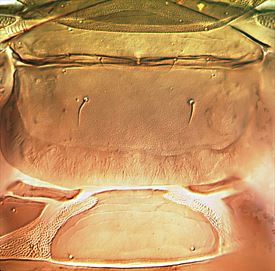Distinguishing features
Female apterous (rarely fully winged). Body brown; base of antennal segment III, tarsi, and apex of tibiae paler; major setae pale. Head with faint lines of sculpture at base; postocular setae acute; a small median pair of setae on vertex; ocelli absent; maxillary stylets about one-third of head width apart, retracted to postocular setae. Antennal segment III slightly smaller than II or IV; VIII scarcely constricted at base; segment III with 1 sense cone, IV with 2 sense cones. Pronotum lacking sculpture; epimeral sutures usually complete; anteromarginal setae minute, other major setae blunt or acute; basantra absent. Mesonotum bearing 1 minute seta laterally; metanotum without sculpture, bearing 1 pair of acute median setae. Mesopresternum reduced to 2 lateral triangles; metathoracic sternopleural sutures short, sometimes reduced or absent. Fore tarsal tooth minute. Pelta faintly sculptured on anterior margin; tergites II–VII each with 1 pair of curved wing-retaining setae, sometimes 2 pairs on VI and VII; tergite IX posteromarginal setae S1 longer than tube, finely acute. Macroptera with ocelli present; metanotum with a few striate lines of sculpture laterally, and 1 pair of acute median setae; fore wings shaded without duplicated cilia; major sub-basal setae S1 blunt, S2 and S3 usually shorter; tergites II–VII each with 2 pairs of wing-retaining setae, the posterior pair sigmoid on III–VII, the remainder usually curved.
Male similar to female aptera, fore tarsal tooth larger; sternite VIII with a transverse pore plate not reaching lateral margins; tergite IX posteromarginal setae S2 shorter, stout.
Related species
The genus Lissothrips comprises 23 species, of which 12 are known only from the Americas, one from Fiji, one from Japan, eight from Australia, and three from New Zealand (of which two are shared with Australia). L. dentatus resembles other members of Lissothrips in the rather stout maxillary stylets and the long setae on tergite IX. However, antennal segment III is not particularly small, basantra are not developed, the pronotal epimeral sutures are complete although weak, and the fore tarsus bears a small tooth.
Biological data
Adults and larvae are apparently associated with lichen on twigs rather than with mosses.
Distribution data
Described from New Zealand (AK, WO / SD, BR, WD), but also recorded from eastern Australia (Mound & Tree, 2015).
Family name
PHLAEOTHRIPIDAE, PHLAEOTHRIPINAE
Species name
Lissothrips dentatus Mound & Walker
Original name and synonyms
Lissothrips dentatus Mound & Walker, 1986: 66
References
Mound LA & Tree DJ (2015) The genus Lissothrips from mosses and lichens in Australia and New Zealand (Thysanoptera, Phlaeothripinae) Zootaxa 3946 (3): 361–373.
Mound LA & Walker AK (1986) Tubulifera (Insecta: Thysanoptera). Fauna of New Zealand 10: 1–140.


